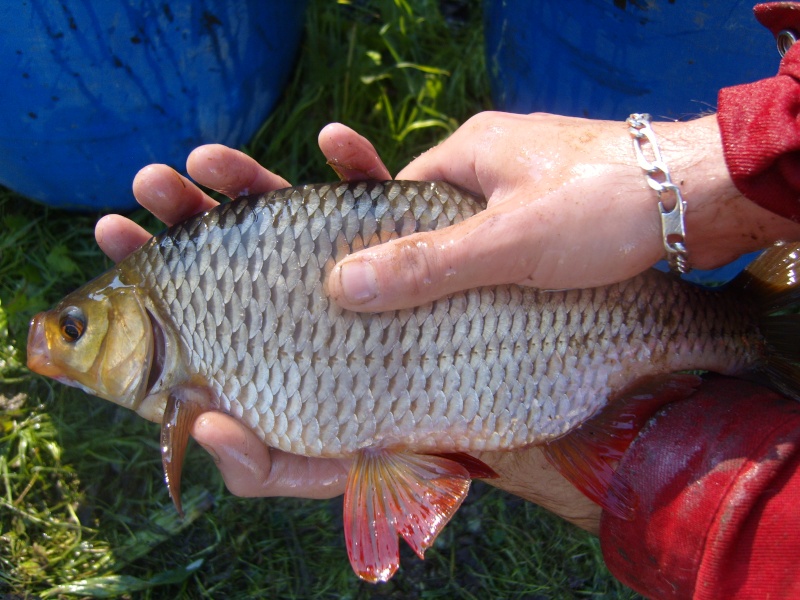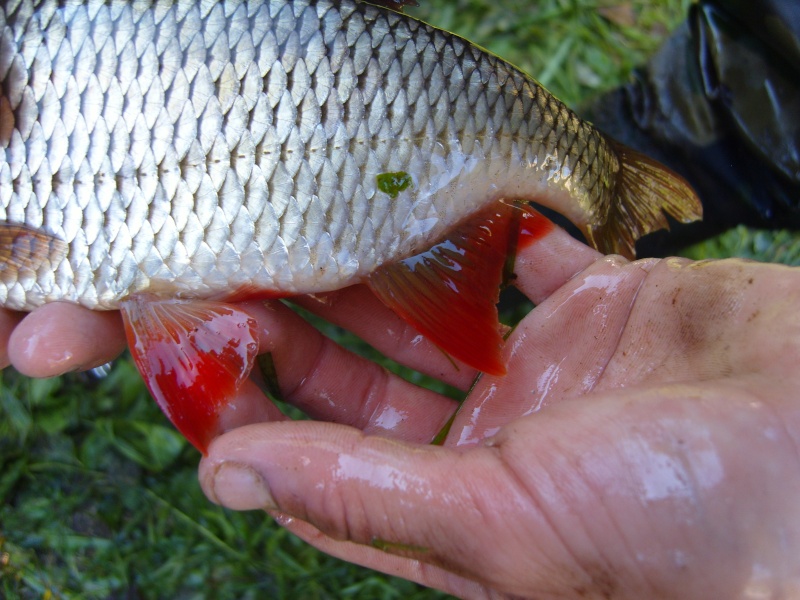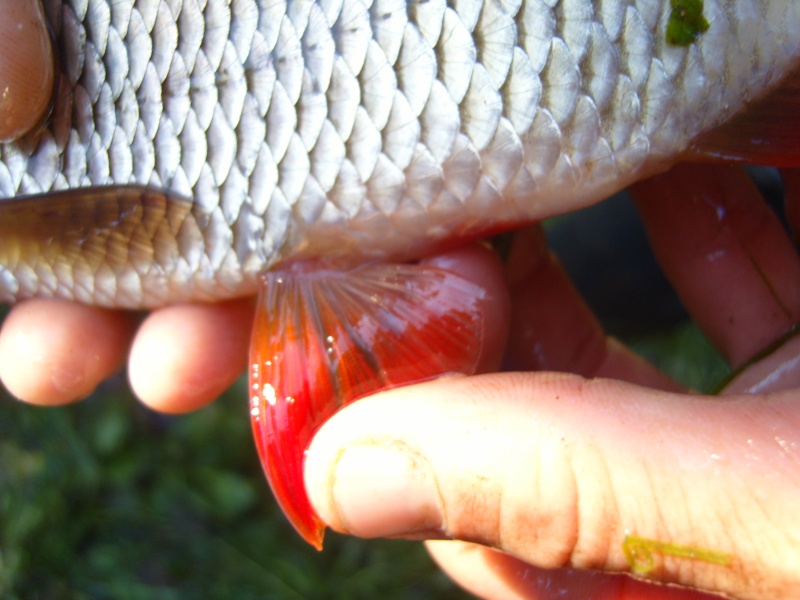| | | The Rotengle: |  |
| | | Author | Message |
|---|
super novice

Number of posts : 142
Location : *******
Registration date : 2008-11-18
 |  Subject: The Rotengle: Subject: The Rotengle:  Mon Jun 08, 2009 5:16 pm Mon Jun 08, 2009 5:16 pm | |
| The rotengle (scardinius erythrophtalmus).

Order: Cypriniformes
Family: Cyprinidés
Kind: Scardinius
Species: Erythrophtalmus
Synonym (S) or Name (S) common (S): Red Rotengle, gardon.

Maximum size: The intermediate size of the rotangle is located at the neighborhoods of 25 cm, the largest subjects being able to reach more than 40 cm for a weight going up to 1 kilo.
Origin: The rotengle, originating in Eurasia is currently present in all Europe except for Italy, Scotland and the north of Scandinavia.
Zone of life: One meets mainly the rotengle in calm water or with very weak current. Thus one finds it in the calm ponds, rivers, the channels as well as the dead arms. He appreciates the zones rich in vegetation near the banks. He is located as well at the bottom (where he finds the essence of his food) as enters two water. In summer one also often finds it surfaces some with the mounting of flying insects.
Temperature: of 5° with 25°C this fish acclimatizes itself very well to the majority of the aquatic environments.
Description: The rotengle has a body very high proportionally with its size (almost oval). Its body is covered with small smooth scales of color grisâtre. Its back is slightly green and the belly is white. All its fins are very red and its tail is lengthened.The rotengle has a small narrow mouth provided with several small teeth pharyngiennes enabling him to break the snail shells. The lower lip of the rotangle being slightly larger than the upper lip that gives an impression of mouth directed slightly upwards.The interior of the eye is of black color and the iris which surrounds it by red color.
 
Nutrition: It nourishes primarily small insects, shellfish, molluscs and towards when those Ci are abundant in water. In winter its mode is primarily vegetable and it then nourishes foams and algae present in water.
Anatomy: very compressed almost oval body. Of color green gray on the top, the sides are cleared up to finish by a white belly. The fins are very red and the lengthened tail.
Behavior: The rotengle is a very peaceful gregarious fish with its congeneric and the other species. It is current in summer to see benches of several hundreds of individuals on the surface.
Dimorphism: no dimorphism noted apart from the period of reproduction. On the other hand during the abrasion, the males present on all the body of the many called white points “buttons of wedding”.
Reproduction: The reproduction of the rotengle proceeds between April and July when the temperature of water is higher than 15°C. The female can lay until 200000 eggs which it disseminates on the watery vegetation present on the edges to see on the bottom. The eggs of approximately 1mm are of red color and hard incubation approximately 2 weeks. The larvae, after resorption of the vitelline bag nourish then phytoplankton and of zooplancton.The rotengle reaches its maturation sexual between 2 and 3 years and it is able once adult, to change sex.
The Council for the fisherman: the rotengle attends the same zones as its counterpart the gardon.
Various: One often confuses the rotengle and the gardon but by them putting side by side, one realizes that the rotengle is higher body than the gardon and than its fins are much redder than those of keep.
It is frequent that the hybrid rotengle with the gardon and the bleak.
Information: the cards of fish can be to supplement by an experiment of the subject, or a comment concerning a lack of information on this card.
Last edited by super novice on Thu Oct 29, 2009 9:36 pm; edited 1 time in total | |
|   | | super novice

Number of posts : 142
Location : *******
Registration date : 2008-11-18
 |  Subject: The Roptengle: Subject: The Roptengle:  Mon Jun 08, 2009 5:23 pm Mon Jun 08, 2009 5:23 pm | |
| Le rotengle (scardinius erythrophtalmus).
Ordre : Cypriniformes.
Famille : Cyprinidés
Genre : Scardinius
Espèce : Erythrophtalmus
Synonyme(s)ou Nom(s) commun(s) : Rotengle, gardon rouge.
Taille maximale : La taille moyenne du rotangle est située aux alentours de 25 cm, les plus gros sujets pouvant atteindre plus de 40 cm pour un poids allant jusqu'à 1 kilo.
Origine : Le rotengle, originaire d'Eurasie est actuellement présent dans toute l'Europe à l'exception de l'Italie, l'Ecosse et le nord de la Scandinavie.
Zone de vie : On rencontre principalement le rotengle dans les eaux calmes ou à très faible courant. Ainsi on le trouve dans les étangs, les rivières calmes, les canaux ainsi que les bras morts. Il apprécie les zones riches en végétation a proximité des berges.
Il se situe aussi bien au fond (où il trouve l'essentiel de sa nourriture) qu’entre deux eaux. En été on le trouve également souvent en surface à l'affût d'insectes volants.
Température : de 5° à 25°C ce poisson s'acclimate très bien à la plupart des milieux aquatiques.
Description : Le rotengle possède un corps très haut proportionnellement à sa taille (presque ovale). Son corps est recouvert de petites écailles lisses de couleur grisâtre. Son dos est légèrement vert et le ventre est blanc. Toutes ses nageoires sont très rouges et sa queue est allongée.
Le rotengle possède une petite bouche étroite munie de plusieurs petites dents pharyngiennes lui permettant de casser les coquilles d'escargots. La lèvre inférieure du rotangle étant légèrement plus grande que la lèvre supérieure cela donne une impression de bouche orientée légèrement vers le haut.
L'intérieur de l'œil est de couleur noire et l'iris qui l'entoure de couleur rouge.
Nutrition : Il se nourrit essentiellement d'insectes, crustacés, mollusques et petits vers lorsque ceux ci sont abondants dans l'eau. En hiver son régime est essentiellement végétal et il se nourrit alors des mousses et des algues présentes dans l'eau.
Anatomie : corps presque ovale très comprimé. De couleur gris vert sur le dessus, les flancs s'éclaircissent pour terminer par un ventre blanc. Les nageoires sont très rouge et la queue allongée.
Comportement : Le rotengle est un poisson grégaire très paisible avec ses congénères et les autres espèces. Il est courant en été de voir des bancs de plusieurs centaines d'individus en surface.
Dimorphisme : aucun dimorphisme constaté en dehors de la période de reproduction. En revanche durant le frai, les mâles présentent sur tout le corps des nombreux points blancs appelés "boutons de noce".
Reproduction : La reproduction du rotengle se déroule entre avril et juillet lorsque la température de l'eau est supérieure à 15°C. La femelle peut pondre jusque 200000 œufs qu'elle dissémine sur la végétation aquatique présente sur les bords voir sur le fond. Les œufs d'environ 1mm sont de couleur rouge et l'incubation dure environ 2 semaines. Les larves, après résorption du sac vitellin se nourrissent ensuite de phytoplancton et de zooplancton.Le rotengle atteint sa maturation sexuel entre 2 et 3 ans et il est capable une fois adulte, de changer de sexe.
Conseil pour le pêcheur : le rotengle fréquente les mêmes zones que son homologue le gardon.
Divers : On confond souvent le rotengle et le gardon mais en les mettant côte à côte, on se rend compte que le rotengle est plus haut de corps que le gardon et que ses nageoires sont beaucoup plus rouges que celles du gardons.
Il est fréquent que le rotengle s'hybride avec le gardon et l'ablette.
Information : les fiches des poissons peuvent être compléter par une expérience du sujet, ou d'un commentaire concernant un manque d'information sur cette fiche.
| |
|   | | | | The Rotengle: |  |
|
| | Permissions in this forum: | You cannot reply to topics in this forum
| |
| |
| |
TRANSLATOR FOR AQUARISTS OF WORLD
_________________
Select your language to translate the forum |
|
| Who is online? | In total there are 6 users online :: 0 Registered, 0 Hidden and 6 Guests None Most users ever online was 57 on Thu Feb 01, 2024 3:36 am |
|
